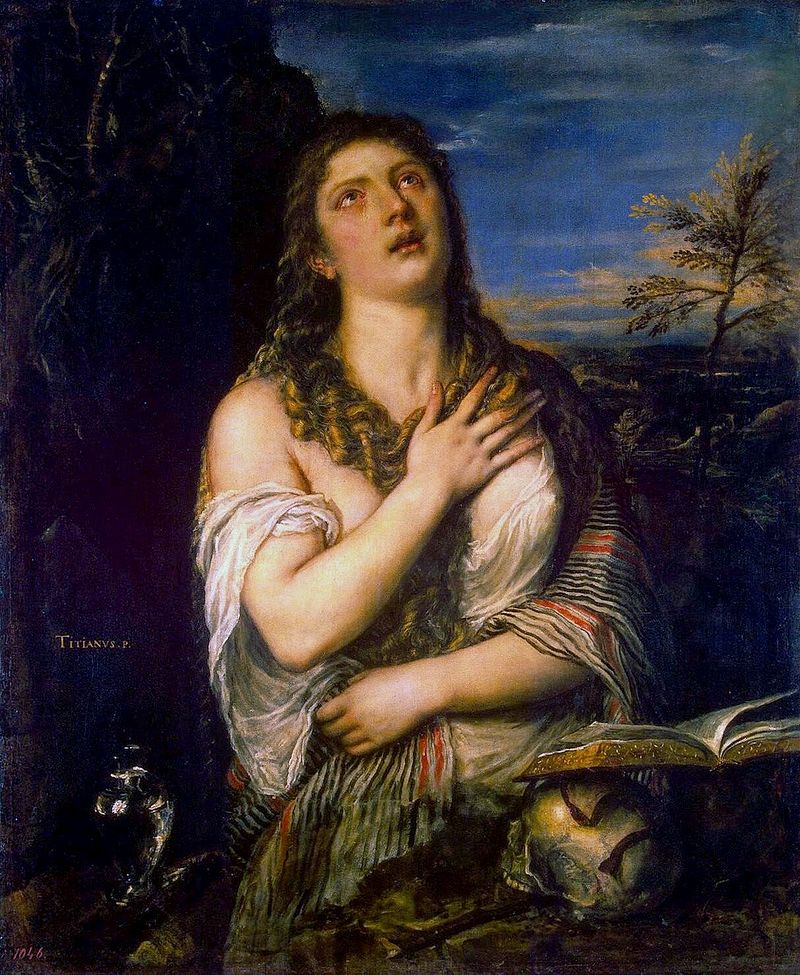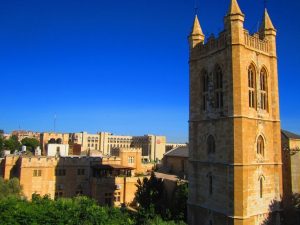* * * *
August 2, 2019 – Last Thursday, July 25, was the feast day for James, son of Zebedee, one of the Twelve Apostles. Tradition adds that he was the first apostle to be martyred, some time around 44 A.D.
He was a son of Zebedee and Salome, and brother of John the Apostle. He is also called James the Greater or James the Great to distinguish him from James, son of Alphaeus.
 For more on this James see Wikipedia, or the post St. James (“10/23”) – and the 7 blind men. (Illustrated at left.)
For more on this James see Wikipedia, or the post St. James (“10/23”) – and the 7 blind men. (Illustrated at left.)
That post noted that October 23 is the Feast Day for another James, the brother of Jesus. Which can be confusing. (Not least of all because there were as many as six or eight “Jameses” in the Bible.) Again, “James (’10/23′)” and see also “Hola! Buen Camino!” (From October 2017.)
[I]n case you’re confused – about the number of “Jameses” in the Bible – there are at least three men named James in the New Testament, and possibly as many as eight. (See “BIO of Philip and James…”) In that list, James the Just (“Brother of Jesus”) is listed third. James the Less – possibly the “son of Alphaeus” – is listed second. Listed first is St. James the Greater – “for whom the Camino de Santiago* is named,” and who is in fact the Patron Saint of Pilgrims. Which is something I mentioned in my last post, On a pilgrimage in Spain.
Which brings up my next pilgrimage. In 2017 – and as noted in the paragraph above – my Utah brother and I hiked (and biked) the most popular “Camino,” the French Way. (In my case, to Santiago de Compostela from Pamplona. where among other things we drank at the Café Iruna of Ernest Hemingway fame – a “whole ‘nother story.”) But a month from now – September 2, 2019 – my brother and I will start hiking the 140 or so miles, from Porto “back” up to Santiago.* Via the Portuguese Way, and this time we’ll be joined by my Utah sister-in-law.
On a related note see Feast of Saint James the Apostle in Spain – timeanddate.com:
Many people in Spain celebrate the life and deeds of James, son of Zebedee, on Saint James’ Day (Santiago Apostol), which is on July 25. Saint James was one of Jesus’ first disciples. Some Christians believe that his remains are buried in Santiago de Compostela in Spain.
The article noted that July 25 is a public holiday in “Basque Country, Cantabria, and Galicia, where it’s a day off for the general population, and schools and most businesses are closed.” (A side note: The “autonomous community” – or province – of Galicia, is in northwestern Spain, and that’s where Santiago de Compostela lies, as the “provincial” capital.)
The article added that: 1) according to Christian tradition this James may have traveled to the area now Santiago; 2) this James was beheaded in Judea in 44 CE, but also that 3) his disciples carried his body by sea to Padrón, on the Galician coast. Then they buried his body “under what is now the cathedral in Santiago de Compostela.”
Which is why it’s popular as a hiking-slash-pilgrimage route. On a related note, see On Mary of Magdala and James the Greater, Saints. Aside from noting – again – that this “July 25” James is the Patron Saint of Pilgrims, the post also cited 2016’s St. James, Steinbeck, and sluts:
The point being that I’ve gone on a few pilgrimages in my time, and am fixing to go on another one this September… And in the Sluts post, I noted that in the spiritual literature of Christianity, the concept of pilgrim and pilgrimage may refer to “the inner path of the spiritual aspirant from a state of wretchedness to a state of beatitude…”
Another side note: It’s better to hike the Camino – in Spain or Portugal – during a month like September, as we did in 2017 and will do again this year. It’s less hot and “touristy.”
See also “On to Jerusalem,” a post about last May’s pilgrimage to Israel:
[A] pilgrimage can be “one of the most chastening, but also one of the most liberating” of personal experiences. [Like] hour after hour of butt-numbing, back-aching canoe-paddling[, for days on end. Or during the 2017 Camino trip where] the chief ordeal was hour after hour of hiking, much of it across the dry and dusty Meseta of northern Spain. Which meant sore achy feet and blister upon blister… So the question for the upcoming trip to Jerusalem: “What part of the trip will help me ‘find a sense of my fragility as a mere human being?’” And “What part of the trip will be ‘most chastening, and also most liberating?’”
And which are some pretty good questions for my upcoming nine-hour flight to Lisbon, and from there to Porto, where three American pilgrims will hike north to Santiago…
So stay tuned! I’ll be posting “further bulletins as events warrant!”
* * * *
* * * *
The original post had an upper image courtesy of Portuguese Camino De Santiago – Image Results, accompanied by a page, “Camino de Santiago – Portuguese Way,” put up by “REI,” that is, Recreational Equipment, Inc. See also Camino Portugués – Camino de Santiago. The caption was “Camino Portugués – one of many Camino(s) de Santiago – that will be “my next great adventure…”
Re: On “St. James the Greater.” As noted in the main text, that post included some regrettable errors about which “James” was involved. On that note, and according to Wikipedia and other sources, “In the Episcopal Church of the U.S.A. and Lutheran Church, James, brother of Jesus and martyr is commemorated on October 23.” But again, the Feast Day for James the Greater is July 25.
On the “Santiago.” Iago is the Spanish form of the name “James,” itself a variation, a “a modern descendant of Iacobus, the Latin form of the Hebrew name Jacob. James is a popular name worldwide, but it is most commonly seen in English-speaking populations.” Other Spanish variations include “Yago” and “Diego.” Thus the town of “Saint Iago.” James (name) – Wikipedia.
Re: Miles from Porto to Santiago. Google Maps had three routes, with two going through Pontevedra, as we will. One of the two routes is 134 miles, the other 141.
Re: John Steinbeck and “sluts.” The “sluts” at issue were mentioned by Robert Louis Stevenson in his ground-breaking 1879 work Travels with a Donkey in the Cévennes. It was considered a “pioneering classic of outdoor literature,” and it inspired Steinbeck‘s 1962 book, Travels with Charley.
Re: My last-May trip to Israel. See On my first full day in Jerusalem, and “Back from three weeks in Israel.” See also “If I Forget Thee, Oh Jerusalem,” for some pre-trip research I did in April.
* * * *


 Next Monday, July 22, is the feast day for
Next Monday, July 22, is the feast day for  Then too there’s
Then too there’s 

 Now I’m back – and don’t have to worry about any more traveling. That is, not until the end of August, when I fly to Lisbon to hike the Portuguese Camino. (From Porto to
Now I’m back – and don’t have to worry about any more traveling. That is, not until the end of August, when I fly to Lisbon to hike the Portuguese Camino. (From Porto to  Which to me illustrates the difference between a real Christian – like Peter – perfectly willing to fall on his face in an effort to emulate Jesus and His path, and the other disciples. Those who stayed safe and sound in the boat, and represent the “many who are called,” but end up turning down Jesus’ invitation to both “
Which to me illustrates the difference between a real Christian – like Peter – perfectly willing to fall on his face in an effort to emulate Jesus and His path, and the other disciples. Those who stayed safe and sound in the boat, and represent the “many who are called,” but end up turning down Jesus’ invitation to both “


 After my adventures in Tel Aviv – getting lost hiking to the train station, taking the wrong train (away from the airport) and going 26 hours without sleep – I had to begin preparing for an 1,100 mile road trip up to
After my adventures in Tel Aviv – getting lost hiking to the train station, taking the wrong train (away from the airport) and going 26 hours without sleep – I had to begin preparing for an 1,100 mile road trip up to  Which is another way of saying John the Baptist served as
Which is another way of saying John the Baptist served as  Then
Then  But of course all that was preceded by getting down to work on Thursday. While the main wedding party worked on “favors,” I helped by staying out of the way. (As in “Lead, follow or get the hell out of the way.”) And by reading a first (1908) edition of
But of course all that was preceded by getting down to work on Thursday. While the main wedding party worked on “favors,” I helped by staying out of the way. (As in “Lead, follow or get the hell out of the way.”) And by reading a first (1908) edition of 
 The Wikipedia caption for the Hadley MA image is “Town Hall and First Congregational Church.” The “Officiant getting some last-minute instructions” photo – which I took – is shown at right.
The Wikipedia caption for the Hadley MA image is “Town Hall and First Congregational Church.” The “Officiant getting some last-minute instructions” photo – which I took – is shown at right.  As noted in the opening
As noted in the opening 

 There was a bit of a problem finding my lodging. (We got there the evening of Saturday, May 11, so I’d had to get lodging for the two nights before the course started, on Monday evening, May 13.) The driver found Al Isfahani Street all right, but had no clue as to the whereabouts of “Herod’s Guest House.” (Near
There was a bit of a problem finding my lodging. (We got there the evening of Saturday, May 11, so I’d had to get lodging for the two nights before the course started, on Monday evening, May 13.) The driver found Al Isfahani Street all right, but had no clue as to the whereabouts of “Herod’s Guest House.” (Near  I wandered around – starting near the Old City and on up Jaffa Street – from 12:30 to 5:15 p.m. local time. Eventually I got over and onto Ha-Neviim Street and west on Jaffa Street, up as far as Sarei Israel Boulevard. (Close to where Herzl comes in to Jaffa.) There I found a liquor store at
I wandered around – starting near the Old City and on up Jaffa Street – from 12:30 to 5:15 p.m. local time. Eventually I got over and onto Ha-Neviim Street and west on Jaffa Street, up as far as Sarei Israel Boulevard. (Close to where Herzl comes in to Jaffa.) There I found a liquor store at  The one at 4:08 in the morning let faithful Muslims know to get up and get something to eat and drink, before the all-day fast. The one around 7:30 p.m. let them know the fast was over – and that they could finally have something to eat and drink.
The one at 4:08 in the morning let faithful Muslims know to get up and get something to eat and drink, before the all-day fast. The one around 7:30 p.m. let them know the fast was over – and that they could finally have something to eat and drink.
 Re:
Re: 
 Another side note: Gentlemen who wear shorts – or otherwise show their knees at “many churches and all Muslim areas in the city” – are also given “skirts.” (Like the two dumbasses at left.)
Another side note: Gentlemen who wear shorts – or otherwise show their knees at “many churches and all Muslim areas in the city” – are also given “skirts.” (Like the two dumbasses at left.)
 We’re now in the “Week of the Second Sunday of Easter (April 28 – May 4).” Which makes this a good time to review
We’re now in the “Week of the Second Sunday of Easter (April 28 – May 4).” Which makes this a good time to review  To make a long story short, it seems to me that
To make a long story short, it seems to me that  In fact his faith grew so much that he became
In fact his faith grew so much that he became 

 As noted in
As noted in  That idea was mirrored in
That idea was mirrored in 

 Back to the main topic:
Back to the main topic:  And of course there’s good old
And of course there’s good old  And speaking of too-far-right conservative Christians who take “an isolated passage from the Bible
And speaking of too-far-right conservative Christians who take “an isolated passage from the Bible 

 And speaking of
And speaking of  In other words, the man with a
In other words, the man with a  Technically the
Technically the 
 Re:
Re: